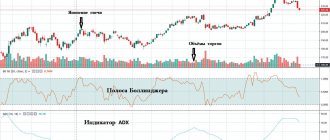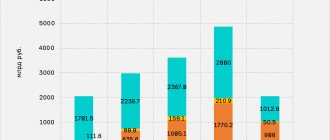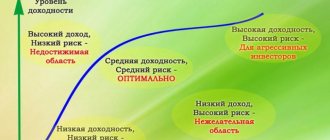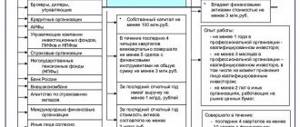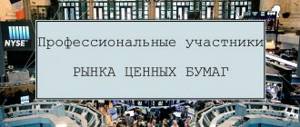Let's look at return on equity . In foreign sources, the return on equity ratio is designated as ROE - Return On Equity (or Return on shareholders' Equity), and shows the share of net profit in the equity capital of the enterprise.
Let's start by defining the economic essence of the return on equity ratio, then we will provide a calculation formula for both domestic and foreign forms of accounting reporting and do not forget to also talk about the standards for this indicator.
Take our proprietary course on choosing stocks on the stock market → training course
Concept and significance for the investor
ROE is a financial indicator of a company's performance. Stands for return on equity. In Russian, it is more often called “return on equity ratio”. Shows how many rubles of net profit each ruble of equity capital invested in the business brings.
Any person who buys shares of a company becomes its shareholder and owner of the business in proportion to his share. He owns the net assets of the company (assets minus liabilities). But they are of interest only in the event of termination of the enterprise's activities. In this case, the shareholder can count on reimbursement of funds in proportion to the share of ownership of the assets.
In a situation where a business is operating and developing, the investor is more interested in the income that it can bring him. Therefore, what becomes more important is not the market value of equity capital itself, but its profitability. This is what the ROE ratio shows.
There is a similar multiplier - ROA, which characterizes the return on investment of all assets, while ROE - only on net assets, i.e. cleared of liabilities.
Summary
ROE is always useful: every shareholder should know how efficiently his personal capital works. But for those investors who want to find out what's behind ROE, DuPont analysis needs to be used to pinpoint what the real problem is and how the business has dealt with it.
In the DuPont model, we look at three separate ratios that can be compared to determine whether it is wise to invest in a company.
⇐ Secrets of making money on stocks. Lesson 9. ROA coefficient Secrets of making money on stocks. Lesson 11. ROI Ratio ⇒
Calculation formula and interpretation of value
Calculation formula:
ROE = Net Profit / Equity * 100%
Net profit is the profit that remains at the disposal of the enterprise after paying mandatory payments. It can be used for development, payment of dividends, and implementation of social events.
Equity is the company's assets (cash and cash equivalents, fixed assets, investments, etc.) minus liabilities (for example, loans and borrowings, accounts payable).
An indicator value of 30% will mean that every ruble of equity capital invested in production will bring shareholders 30 kopecks of net profit. The higher this percentage, the better the company generates profit from its own funds and the more profitable its securities are for investors.
A negative value means that the company is at a loss, i.e. its net profit has gone negative, is unprofitable and investing money in the purchase of its shares is inappropriate.
Complete information about current strategies that have already brought millions of passive income to investors
An investor can receive the profit that equity brings in two ways:
- In the form of dividends. Some companies allocate up to 50% of net profit for payments, others – up to 100%.
- In the form of rising stock prices. This will happen if the company decides not to use net profit to pay dividends, but to invest money in development (equipment modernization, new investment projects, etc.). With effective management in the future, this will lead to an increase in the value of the company.
The components of the formula can be found in both Russian (RAS) and international (IFRS) reporting. The calculation method came to our country from abroad, so most often the indicator is calculated using second reporting. All public companies are required to provide freely available IFRS reporting on their official website, so calculating profitability is not difficult.
Net income is included in the Consolidated Statement of Income and Other Comprehensive Income. Own capital can be obtained in two ways:
- The difference between the line “Total assets” and “Total liabilities” in the Consolidated Statement of Financial Position.
- Line “Total equity” in the Consolidated Statement of Financial Position.
Features of the return on equity ratio:
- There is no standard value for the indicator. The only thing we can say with certainty is that it should be higher than the yield of conservative instruments (deposits, OFZs). But investors typically look at double-digit values when deciding whether to buy a company's securities.
- There is no point in calculating the coefficient for enterprises that belong to different industries. For example, an IT business does not need many assets to generate profit. And enterprises from the oil and gas industry cannot do without fixed assets. And the more of these funds there are, the better. The last statement is relevant for a business that effectively manages them.
- To analyze a company, you should look at the profitability ratio over time. This will allow us to draw conclusions more objectively.
- The indicator alone cannot serve as a guide when making a decision to purchase shares of a particular company. It is informative only in combination with other animators.
03.09.2020
135
What is EBITDA in economics: calculation methods, pros and cons of the indicator
Hello, friends! Today we will analyze a financial indicator, the name of which for the unprepared...
Return on equity. Standard
The average ROE in the US and UK is 10-12%. For inflationary economies, the coefficient is higher. According to the international rating agency S&P, the return on equity ratio of Russian enterprises was 12% in 2010, the forecast for 2011 was 15%, for 2012 – 17%. Domestic economists believe that 20% is a normal value for return on equity .
The main criterion for assessing the return on equity ratio is to compare it with the alternative return that an investor can receive from investing in other projects. As discussed in the example above, investing in KAMAZ OJSC was not effective.
Author: Zhdanov Vasily Yurievich, Ph.D.
| Business valuation | Financial analysis according to IFRS | Financial analysis according to RAS |
| Calculation of NPV, IRR in Excel | Valuation of stocks and bonds |
Calculation examples
Let's consider the calculation of ROE using the example of three companies - representatives of the Russian metallurgical industry:
- PJSC Severstal.
- PJSC Novolipetsk Metallurgical Plant (NLMK).
- PJSC Magnitogorsk Iron and Steel Works (MMK).
Let's take 2021 as the calculation period. The source of initial data is consolidated financial statements under IFRS. For NLMK, data are presented in US dollars, for the other two companies - in rubles. There is no point in converting to single units of measurement, because we are calculating the relative profitability indicator as a percentage.
| Indicators | Severstal | NLMK | MMK |
| Net profit | RUB 114,361 million | $1,341 million | RUB 55,617 million |
| Equity | RUB 215,291 million | $5,947 million | RUB 341,641 million |
| ROE | 53,12 % | 22,55 % | 16,28 % |
When comparing the return on equity of three metallurgical companies, Severstal is the most efficient. But we always remember that you cannot base your decision to buy or sell shares on just one indicator. And it is advisable to analyze the dynamics for at least the last 3 years.
Using Severstal as an example, let's look at where to look for the initial data for the calculation:
- on the official website, in the “Investors” tab, select “Financial results”, in our case, financial statements in rubles for the 4th quarter of 2021;
- in the Consolidated Statement of Profit and Loss we are interested in the net profit indicator;
- in the Consolidated Statement of Financial Position we look for the line “Total capital”;
Example of ROI calculation
For example, a company sells office supplies and advertises its activities in a local newspaper and on a radio station. 100 thousand rubles per year are spent on an advertising campaign. When a new client applies, they ask him about the sources from which he received information about the company. If from the radio or newspaper, the total cost of his purchases is entered into a special account.
After a year, the results are analyzed. If it turns out that during the year all the clients who came through advertising brought profit to the company in the amount of 300 thousand rubles, then, knowing this amount, you can calculate the effectiveness of investments (in this case, the profitability of investments in advertising):
ROI = Money Earned / Costs * 100% = 300,000 / 100,000 * 100% = 300%
Consequently, every ruble spent on advertising brought the company 3 rubles of profit.
Dupont model
A more complex formula for calculating ROE is the DuPont model. She breaks down the indicator into 3 factors in order to assess the impact of each on the final result.
Dupont model:
ROE = Net Profit / Revenue x Revenue / Assets x Assets / Equity x 100%
If you are a little familiar with mathematics, you will easily see that this formula is nothing more than the ratio of net profit to equity.
Purpose of multipliers:
- Net profit / Revenue – return on sales. Shows how much net profit is received for each ruble of work/services/products sold.
- Revenue / Assets – asset turnover. Shows how much revenue the company receives from each invested ruble of assets.
- Assets/Equity – financial leverage. Shows the relationship between total assets and net assets, i.e. excluding liabilities. This is an indicator of the effectiveness of the use of borrowed funds.
A factor breakdown allows you to assess the strengths and weaknesses of a company in more detail and adjust economic policy.
Analysis methods
Parametric statistical methods are used to analyze return on investment. Financiers divide the analysis of investment profitability into two types:
- Discrete method.
- Accounting method.
To make the most accurate ROI calculations, an investor or company manager must take into account each type of spending (on advertising, product promotion, etc.). Then the results obtained will be reliable, and the predictions made on the basis of their analysis will be plausible.
ROI ratio analysis helps to make optimal use of financial resources. In this case, two problems of rational use of investment funds can be solved:
- When the volume of investment for a project is determined, we must try to get the maximum result from the use of these funds;
- For a given result, which must be obtained through investment capital, it is necessary to minimize the costs of investment funds.
The ROI structure implies 4 categories of possible profit that can be obtained during the implementation of the project:
- Reduce labor costs (labor intensity);
- Reduce capital costs (cost of materials, electricity, etc.);
- Increase labor productivity;
- Increase business profits.
Romi coefficient
To calculate the return on investment in advertising, the Romi coefficient, the so-called marketing ROI, is used. It differs from ROI for business in that it does not take into account the cost of goods, expenses, logistics, wages, etc. The coefficient only calculates the costs of an advertising campaign, that is, marketing investments.
Romi = (Total Profit – Advertising Expenses) / Advertising Expenses * 100%
To calculate Romi you need to consider:
- Marginal profitability or markup;
- Advertising campaign budget;
- Profit from an advertising campaign.
An indicator greater than 100% means that the investment in the advertising campaign has paid off and has begun to generate profit. If the indicator is 100%, the profit received is twice the investment in advertising. If the indicator value is negative, investments in the advertising campaign are not effective.
Using the Target ROAS strategy greatly increases the value of trading companies.
Difficulties
In practice, there may be some difficulties in calculating ROI:
- Estimating future cash flows can be a major challenge. The financial system depends on many factors: fluctuations in the price of raw materials and supplies, regulator interest rates, seasonality of supply and demand, and other things;
- Estimation of discount rates, that is, determination of the time price of funds, expressing future monetary transactions in units of present time.
